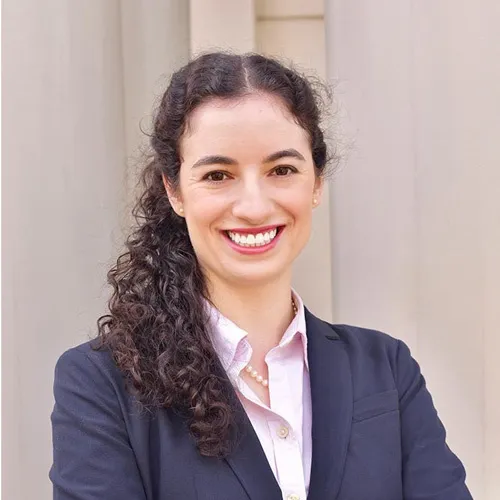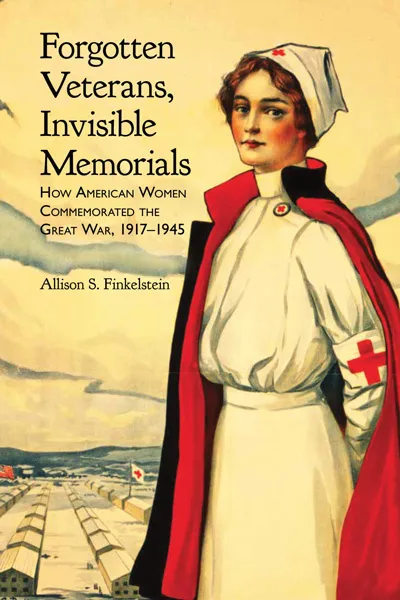- December 08, 2021
- By Maggie Haslam
Over 16,000 women served overseas during World War I. Yet as Armistice Day marked the war’s final chapter, the stories of women who sacrificed—in overseas hospitals or as wives and mothers back home—were destined to become footnotes.

More than a century later, a University of Maryland graduate is rewriting that narrative, revealing the grassroots efforts spearheaded by women of the WWI generation to honor this service, not carved in marble statuary, but through community service and advocacy and in hospitals and respite houses.
In "Forgotten Veterans, Invisible Memorials: How American Women Commemorated the Great War, 1917-1945,” from the University of Alabama Press, historian Allison Finkelstein M.A. ’12, Ph.D. ’15 tells the stories behind the work to commemorate wartime sacrifices through living memorials—intangible commemorations grounded in continued service to the country. Coined “veteranism” by Finkelstein, they included a push for female veteran assistance, an orphanage for French girls impacted by the war, and pilgrimages to visit soldiers buried overseas.
“I think one of the challenges of tangible memorials that are intended to be permanent is that history is not static,” she said. “Finding ways to commemorate that are less focused on just building something can put those resources into projects that can help the community.”

Finkelstein’s book is inspired by her research as a graduate student in history at Maryland, where she specialized in cultural history under Associate Professor Saverio Giovacchini. During a summer internship with the American Battle Monuments Commission, which manages overseas cemeteries and memorials, archival research introduced her to Gold Star pilgrimages, all-expenses-paid trips for women who lost a child or husband in the war to visit their distant graves. It was there she saw the small craftsman bungalows that edged some of the cemeteries, once used as places of respite for the visiting women. Working with Professor Donald Linebaugh, who advised her as part of a certificate in historic preservation, she wrote a research paper about these small structures that she later published, sowing the seed that eventually became “Forgotten Veterans, Invisible Memorials.”
Living memorials, said Finkelstein, show that there’s more than one way to commemorate and remember service. But in the case of WWI, they served another purpose as well: to ensure that women’s many contributions to the war effort—whether as physical therapists or telephone operators, or by replacing men in the workforce to keep food on the table—were not left out of the history books. Among the examples she explored:
- After Germans executed British nurse Edith Cavell in 1915, a group of Bostonians designated an American nurse, Alice L.F. Fitzgerald, to travel overseas to serve with the British and French in Cavell’s honor, even though the United States had not yet joined the war, a source shared with Finkelstein by UMD Professor Marian Moser Jones in the Department of Family Science. Fitzgerald’s letters as the Edith Cavell Memorial Nurse were published in U.S. newspapers to raise funds to support her work overseas.
- American sculptor Anna Coleman Ladd established the American Red Cross Studio for Portrait Masks in 1917 in Paris to transform the faces of soldiers who suffered disfiguration during the war, an act of veteranism Finkelstein considers one of the truest forms of living memorials. Ladd later designed several memorials dedicated to the ugliest aspects of the Great War, some of which survive today.
- The Women’s Overseas Service League was one of the most important organizations to support and advocate for women who served abroad during the Great War. Because many of the women were not officially serving with the U.S. military, they were excluded from veteran’s benefits; one of WOSL’s greatest commemorative gestures was establishing a fund to support disabled, ill or financially unstable former servicewomen.
- Architecture firm Trowbridge and Livingston added special dedications to the bases of all but one column of the Red Cross’s Memorial Building to the Women of the World War in Washington, D.C., a patchwork of the many different wartime contributions of women. The one blank column is thought to symbolize the rejection of traditional memorials by many female veteranists. The building is a unique example of combined physical commemoration and a living memorial, housing a myriad of continued service activities.
Finkelstein, now a senior historian at Arlington National Cemetery, will share some of the stories from her book with UMD’s Miller Center for Historical Studies on Dec. 9.
“Women’s service is much more complex than what we would see if we only go by the timeline of when women were actually admitted into the military,” she said. “I hope this book helps get these women's stories into the historical record and that it means more people will learn about them.”
